Child Abuse in Canada: Laws and Rehabilitation Programs
VerifiedAdded on 2023/06/15
|7
|1858
|264
AI Summary
This article discusses the laws and rehabilitation programs in Canada for child abuse. It emphasizes on the issues faced by Aboriginal children exposed to violence within the family. The Child Family and Community Service Act is a current law that has been introduced in Canada for the addressing the issues related to child abuse. The penalties and rehabilitation programs for child abuse have been implemented in order to provide appropriate punishment to the offenders of child abuse. However, the Act failed to provide the appropriate intervention and treatment to abused victims. The Act failed to intervene into the activities of the existing residential schools.
Contribute Materials
Your contribution can guide someone’s learning journey. Share your
documents today.
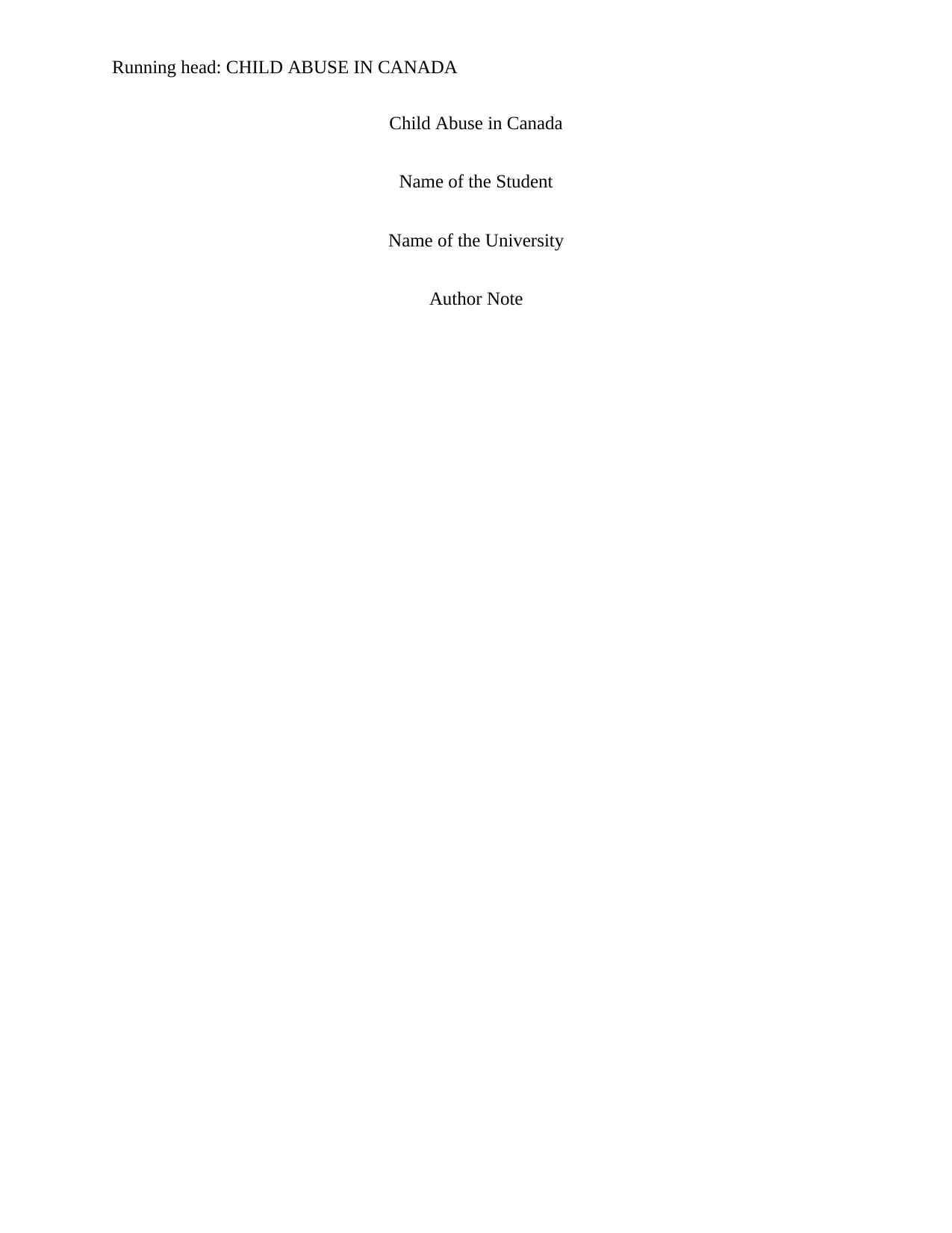
Running head: CHILD ABUSE IN CANADA
Child Abuse in Canada
Name of the Student
Name of the University
Author Note
Child Abuse in Canada
Name of the Student
Name of the University
Author Note
Secure Best Marks with AI Grader
Need help grading? Try our AI Grader for instant feedback on your assignments.
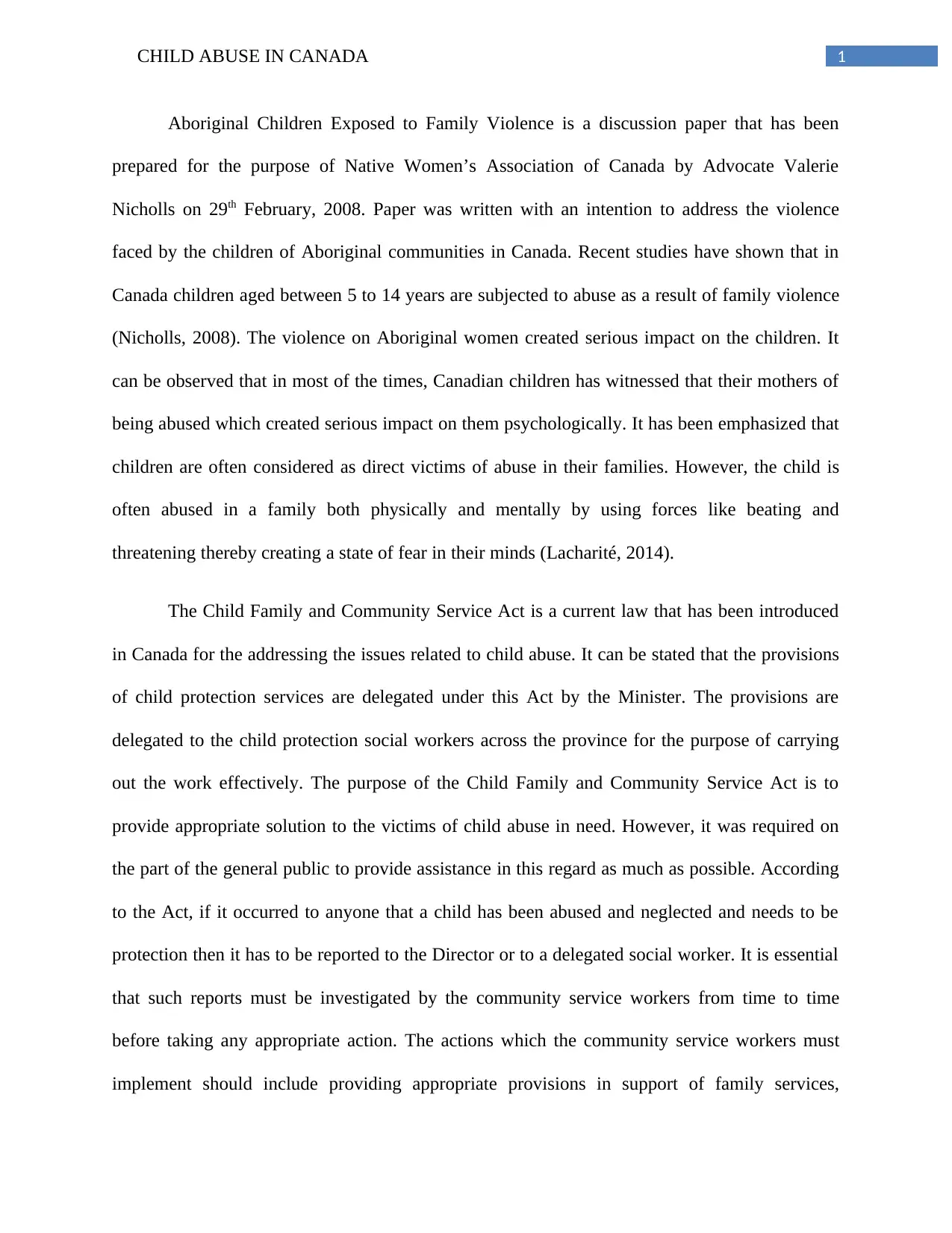
1CHILD ABUSE IN CANADA
Aboriginal Children Exposed to Family Violence is a discussion paper that has been
prepared for the purpose of Native Women’s Association of Canada by Advocate Valerie
Nicholls on 29th February, 2008. Paper was written with an intention to address the violence
faced by the children of Aboriginal communities in Canada. Recent studies have shown that in
Canada children aged between 5 to 14 years are subjected to abuse as a result of family violence
(Nicholls, 2008). The violence on Aboriginal women created serious impact on the children. It
can be observed that in most of the times, Canadian children has witnessed that their mothers of
being abused which created serious impact on them psychologically. It has been emphasized that
children are often considered as direct victims of abuse in their families. However, the child is
often abused in a family both physically and mentally by using forces like beating and
threatening thereby creating a state of fear in their minds (Lacharité, 2014).
The Child Family and Community Service Act is a current law that has been introduced
in Canada for the addressing the issues related to child abuse. It can be stated that the provisions
of child protection services are delegated under this Act by the Minister. The provisions are
delegated to the child protection social workers across the province for the purpose of carrying
out the work effectively. The purpose of the Child Family and Community Service Act is to
provide appropriate solution to the victims of child abuse in need. However, it was required on
the part of the general public to provide assistance in this regard as much as possible. According
to the Act, if it occurred to anyone that a child has been abused and neglected and needs to be
protection then it has to be reported to the Director or to a delegated social worker. It is essential
that such reports must be investigated by the community service workers from time to time
before taking any appropriate action. The actions which the community service workers must
implement should include providing appropriate provisions in support of family services,
Aboriginal Children Exposed to Family Violence is a discussion paper that has been
prepared for the purpose of Native Women’s Association of Canada by Advocate Valerie
Nicholls on 29th February, 2008. Paper was written with an intention to address the violence
faced by the children of Aboriginal communities in Canada. Recent studies have shown that in
Canada children aged between 5 to 14 years are subjected to abuse as a result of family violence
(Nicholls, 2008). The violence on Aboriginal women created serious impact on the children. It
can be observed that in most of the times, Canadian children has witnessed that their mothers of
being abused which created serious impact on them psychologically. It has been emphasized that
children are often considered as direct victims of abuse in their families. However, the child is
often abused in a family both physically and mentally by using forces like beating and
threatening thereby creating a state of fear in their minds (Lacharité, 2014).
The Child Family and Community Service Act is a current law that has been introduced
in Canada for the addressing the issues related to child abuse. It can be stated that the provisions
of child protection services are delegated under this Act by the Minister. The provisions are
delegated to the child protection social workers across the province for the purpose of carrying
out the work effectively. The purpose of the Child Family and Community Service Act is to
provide appropriate solution to the victims of child abuse in need. However, it was required on
the part of the general public to provide assistance in this regard as much as possible. According
to the Act, if it occurred to anyone that a child has been abused and neglected and needs to be
protection then it has to be reported to the Director or to a delegated social worker. It is essential
that such reports must be investigated by the community service workers from time to time
before taking any appropriate action. The actions which the community service workers must
implement should include providing appropriate provisions in support of family services,
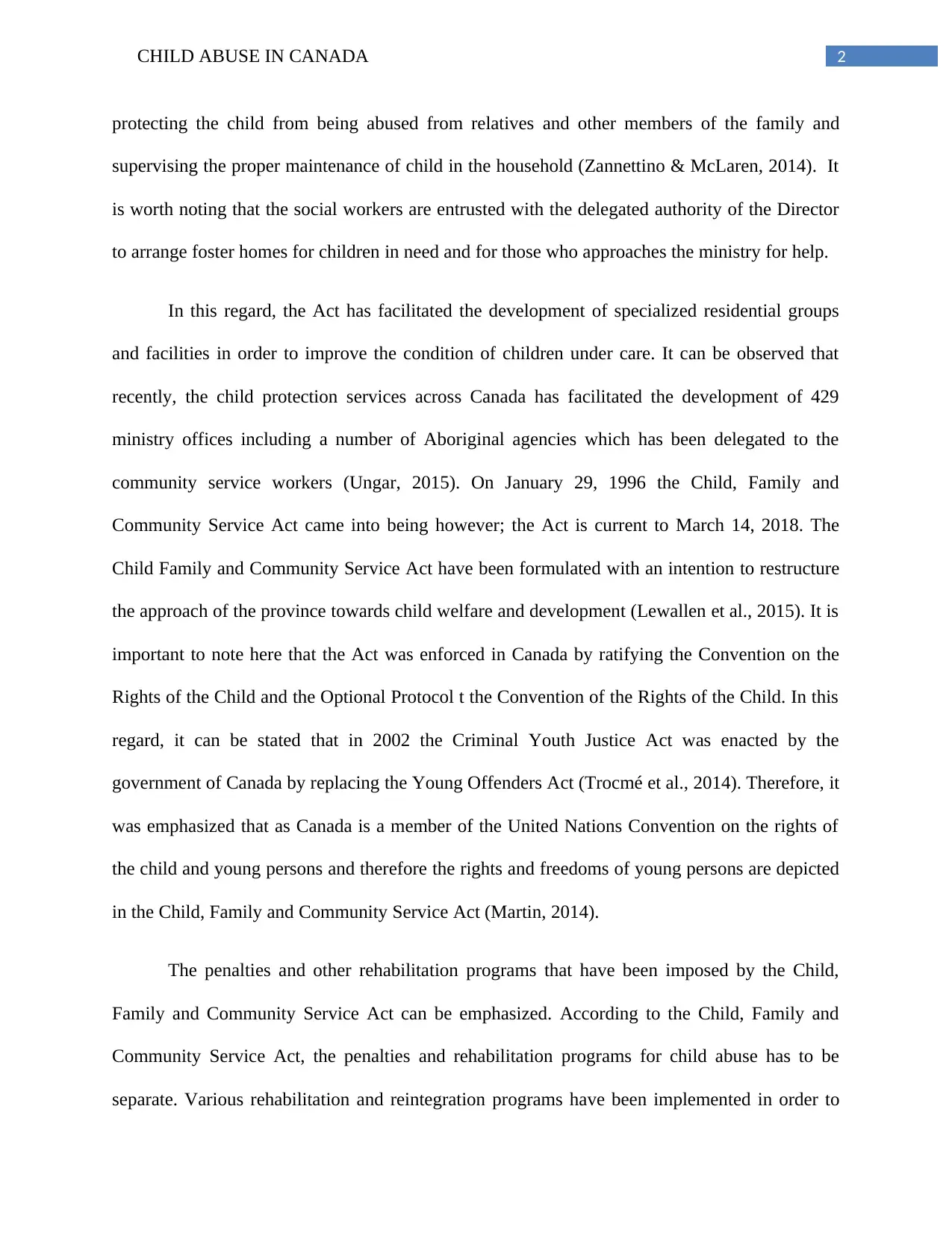
2CHILD ABUSE IN CANADA
protecting the child from being abused from relatives and other members of the family and
supervising the proper maintenance of child in the household (Zannettino & McLaren, 2014). It
is worth noting that the social workers are entrusted with the delegated authority of the Director
to arrange foster homes for children in need and for those who approaches the ministry for help.
In this regard, the Act has facilitated the development of specialized residential groups
and facilities in order to improve the condition of children under care. It can be observed that
recently, the child protection services across Canada has facilitated the development of 429
ministry offices including a number of Aboriginal agencies which has been delegated to the
community service workers (Ungar, 2015). On January 29, 1996 the Child, Family and
Community Service Act came into being however; the Act is current to March 14, 2018. The
Child Family and Community Service Act have been formulated with an intention to restructure
the approach of the province towards child welfare and development (Lewallen et al., 2015). It is
important to note here that the Act was enforced in Canada by ratifying the Convention on the
Rights of the Child and the Optional Protocol t the Convention of the Rights of the Child. In this
regard, it can be stated that in 2002 the Criminal Youth Justice Act was enacted by the
government of Canada by replacing the Young Offenders Act (Trocmé et al., 2014). Therefore, it
was emphasized that as Canada is a member of the United Nations Convention on the rights of
the child and young persons and therefore the rights and freedoms of young persons are depicted
in the Child, Family and Community Service Act (Martin, 2014).
The penalties and other rehabilitation programs that have been imposed by the Child,
Family and Community Service Act can be emphasized. According to the Child, Family and
Community Service Act, the penalties and rehabilitation programs for child abuse has to be
separate. Various rehabilitation and reintegration programs have been implemented in order to
protecting the child from being abused from relatives and other members of the family and
supervising the proper maintenance of child in the household (Zannettino & McLaren, 2014). It
is worth noting that the social workers are entrusted with the delegated authority of the Director
to arrange foster homes for children in need and for those who approaches the ministry for help.
In this regard, the Act has facilitated the development of specialized residential groups
and facilities in order to improve the condition of children under care. It can be observed that
recently, the child protection services across Canada has facilitated the development of 429
ministry offices including a number of Aboriginal agencies which has been delegated to the
community service workers (Ungar, 2015). On January 29, 1996 the Child, Family and
Community Service Act came into being however; the Act is current to March 14, 2018. The
Child Family and Community Service Act have been formulated with an intention to restructure
the approach of the province towards child welfare and development (Lewallen et al., 2015). It is
important to note here that the Act was enforced in Canada by ratifying the Convention on the
Rights of the Child and the Optional Protocol t the Convention of the Rights of the Child. In this
regard, it can be stated that in 2002 the Criminal Youth Justice Act was enacted by the
government of Canada by replacing the Young Offenders Act (Trocmé et al., 2014). Therefore, it
was emphasized that as Canada is a member of the United Nations Convention on the rights of
the child and young persons and therefore the rights and freedoms of young persons are depicted
in the Child, Family and Community Service Act (Martin, 2014).
The penalties and other rehabilitation programs that have been imposed by the Child,
Family and Community Service Act can be emphasized. According to the Child, Family and
Community Service Act, the penalties and rehabilitation programs for child abuse has to be
separate. Various rehabilitation and reintegration programs have been implemented in order to
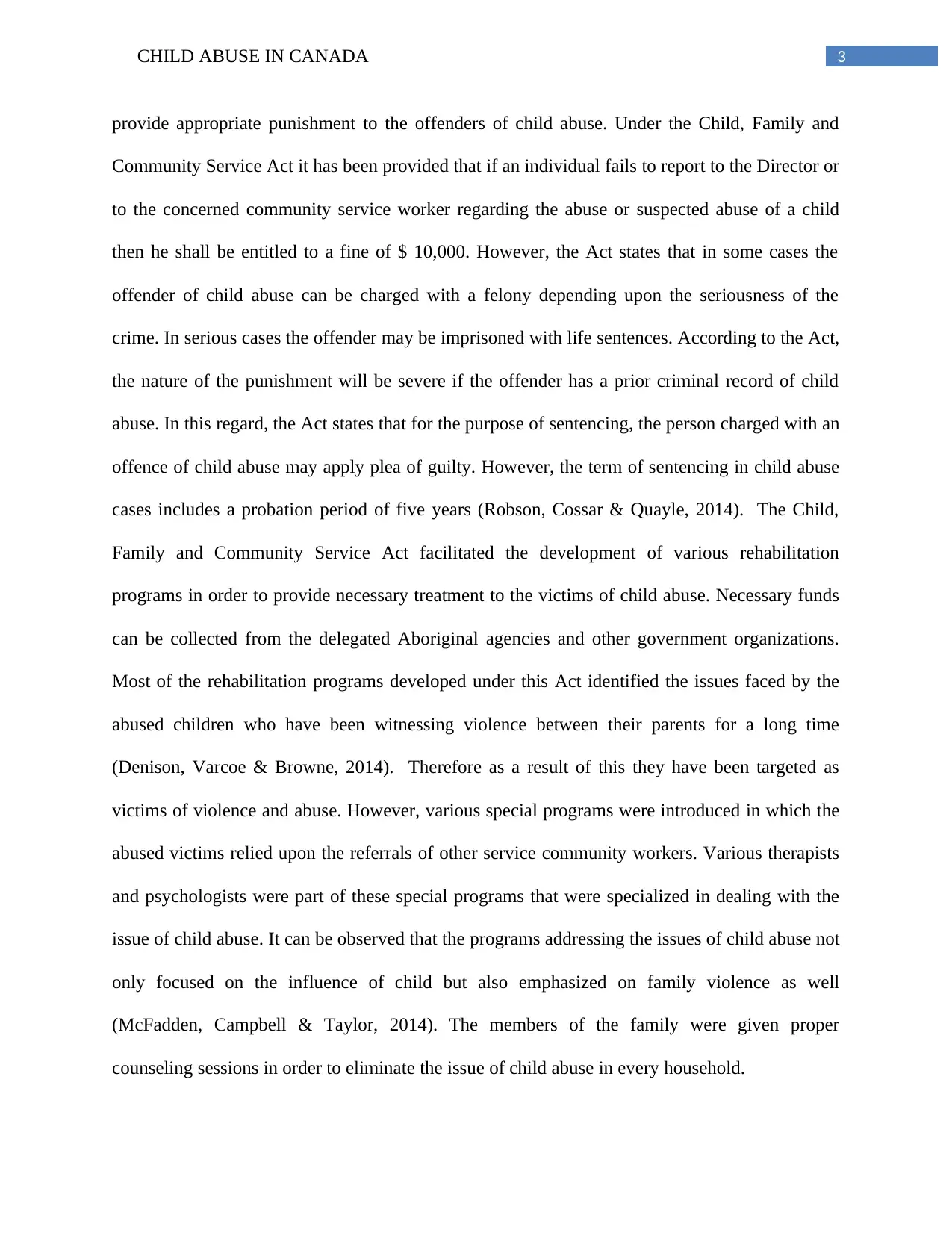
3CHILD ABUSE IN CANADA
provide appropriate punishment to the offenders of child abuse. Under the Child, Family and
Community Service Act it has been provided that if an individual fails to report to the Director or
to the concerned community service worker regarding the abuse or suspected abuse of a child
then he shall be entitled to a fine of $ 10,000. However, the Act states that in some cases the
offender of child abuse can be charged with a felony depending upon the seriousness of the
crime. In serious cases the offender may be imprisoned with life sentences. According to the Act,
the nature of the punishment will be severe if the offender has a prior criminal record of child
abuse. In this regard, the Act states that for the purpose of sentencing, the person charged with an
offence of child abuse may apply plea of guilty. However, the term of sentencing in child abuse
cases includes a probation period of five years (Robson, Cossar & Quayle, 2014). The Child,
Family and Community Service Act facilitated the development of various rehabilitation
programs in order to provide necessary treatment to the victims of child abuse. Necessary funds
can be collected from the delegated Aboriginal agencies and other government organizations.
Most of the rehabilitation programs developed under this Act identified the issues faced by the
abused children who have been witnessing violence between their parents for a long time
(Denison, Varcoe & Browne, 2014). Therefore as a result of this they have been targeted as
victims of violence and abuse. However, various special programs were introduced in which the
abused victims relied upon the referrals of other service community workers. Various therapists
and psychologists were part of these special programs that were specialized in dealing with the
issue of child abuse. It can be observed that the programs addressing the issues of child abuse not
only focused on the influence of child but also emphasized on family violence as well
(McFadden, Campbell & Taylor, 2014). The members of the family were given proper
counseling sessions in order to eliminate the issue of child abuse in every household.
provide appropriate punishment to the offenders of child abuse. Under the Child, Family and
Community Service Act it has been provided that if an individual fails to report to the Director or
to the concerned community service worker regarding the abuse or suspected abuse of a child
then he shall be entitled to a fine of $ 10,000. However, the Act states that in some cases the
offender of child abuse can be charged with a felony depending upon the seriousness of the
crime. In serious cases the offender may be imprisoned with life sentences. According to the Act,
the nature of the punishment will be severe if the offender has a prior criminal record of child
abuse. In this regard, the Act states that for the purpose of sentencing, the person charged with an
offence of child abuse may apply plea of guilty. However, the term of sentencing in child abuse
cases includes a probation period of five years (Robson, Cossar & Quayle, 2014). The Child,
Family and Community Service Act facilitated the development of various rehabilitation
programs in order to provide necessary treatment to the victims of child abuse. Necessary funds
can be collected from the delegated Aboriginal agencies and other government organizations.
Most of the rehabilitation programs developed under this Act identified the issues faced by the
abused children who have been witnessing violence between their parents for a long time
(Denison, Varcoe & Browne, 2014). Therefore as a result of this they have been targeted as
victims of violence and abuse. However, various special programs were introduced in which the
abused victims relied upon the referrals of other service community workers. Various therapists
and psychologists were part of these special programs that were specialized in dealing with the
issue of child abuse. It can be observed that the programs addressing the issues of child abuse not
only focused on the influence of child but also emphasized on family violence as well
(McFadden, Campbell & Taylor, 2014). The members of the family were given proper
counseling sessions in order to eliminate the issue of child abuse in every household.
Secure Best Marks with AI Grader
Need help grading? Try our AI Grader for instant feedback on your assignments.
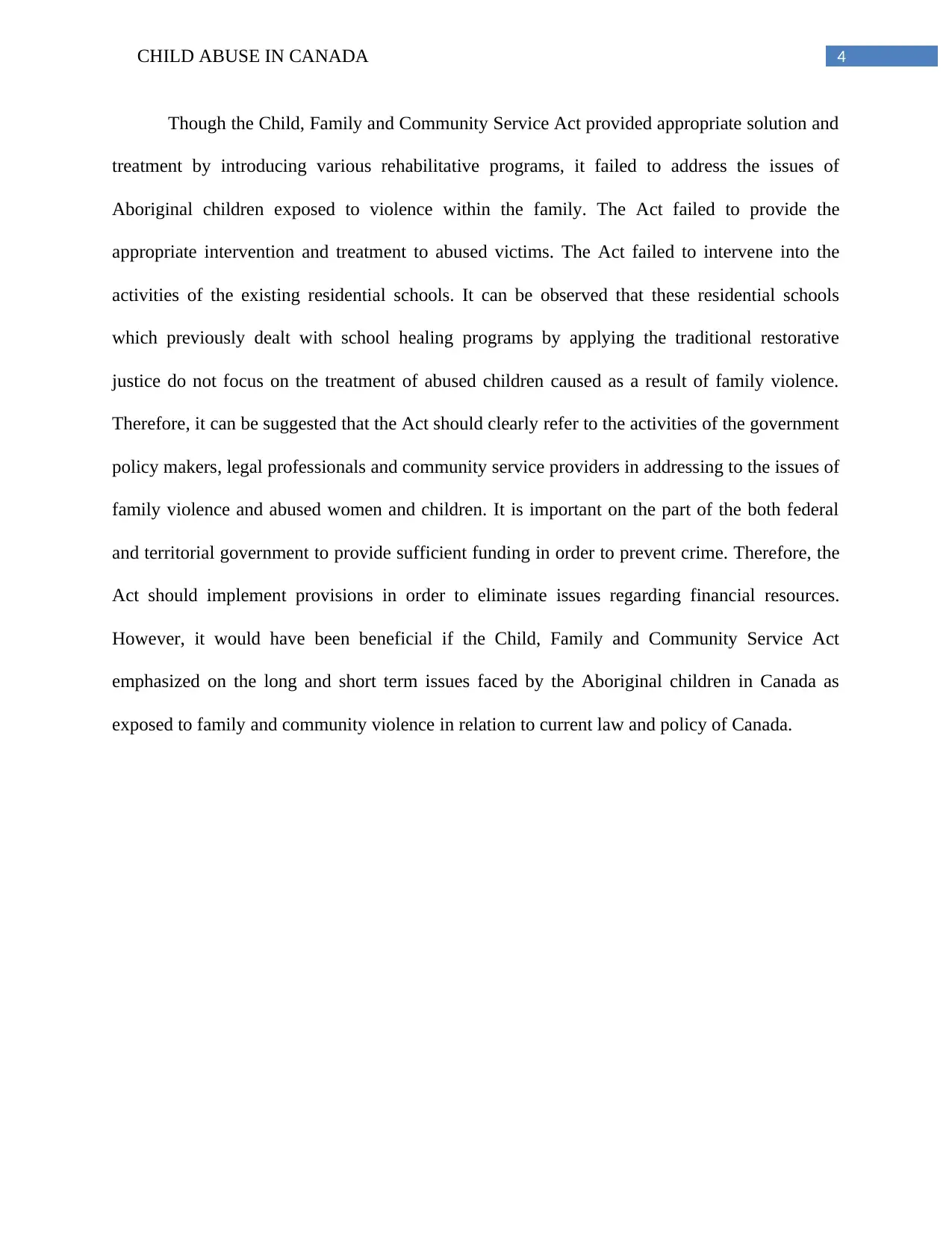
4CHILD ABUSE IN CANADA
Though the Child, Family and Community Service Act provided appropriate solution and
treatment by introducing various rehabilitative programs, it failed to address the issues of
Aboriginal children exposed to violence within the family. The Act failed to provide the
appropriate intervention and treatment to abused victims. The Act failed to intervene into the
activities of the existing residential schools. It can be observed that these residential schools
which previously dealt with school healing programs by applying the traditional restorative
justice do not focus on the treatment of abused children caused as a result of family violence.
Therefore, it can be suggested that the Act should clearly refer to the activities of the government
policy makers, legal professionals and community service providers in addressing to the issues of
family violence and abused women and children. It is important on the part of the both federal
and territorial government to provide sufficient funding in order to prevent crime. Therefore, the
Act should implement provisions in order to eliminate issues regarding financial resources.
However, it would have been beneficial if the Child, Family and Community Service Act
emphasized on the long and short term issues faced by the Aboriginal children in Canada as
exposed to family and community violence in relation to current law and policy of Canada.
Though the Child, Family and Community Service Act provided appropriate solution and
treatment by introducing various rehabilitative programs, it failed to address the issues of
Aboriginal children exposed to violence within the family. The Act failed to provide the
appropriate intervention and treatment to abused victims. The Act failed to intervene into the
activities of the existing residential schools. It can be observed that these residential schools
which previously dealt with school healing programs by applying the traditional restorative
justice do not focus on the treatment of abused children caused as a result of family violence.
Therefore, it can be suggested that the Act should clearly refer to the activities of the government
policy makers, legal professionals and community service providers in addressing to the issues of
family violence and abused women and children. It is important on the part of the both federal
and territorial government to provide sufficient funding in order to prevent crime. Therefore, the
Act should implement provisions in order to eliminate issues regarding financial resources.
However, it would have been beneficial if the Child, Family and Community Service Act
emphasized on the long and short term issues faced by the Aboriginal children in Canada as
exposed to family and community violence in relation to current law and policy of Canada.
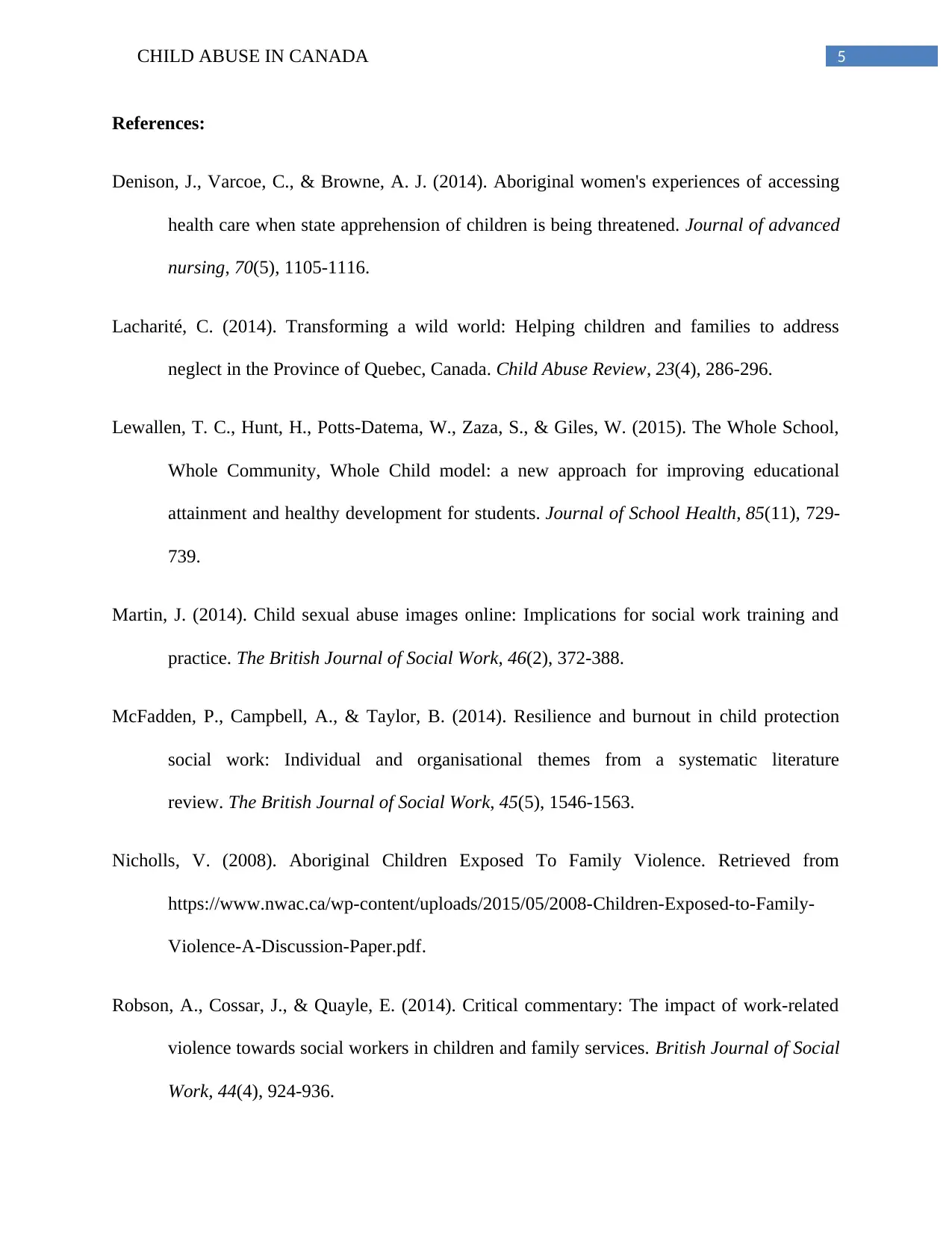
5CHILD ABUSE IN CANADA
References:
Denison, J., Varcoe, C., & Browne, A. J. (2014). Aboriginal women's experiences of accessing
health care when state apprehension of children is being threatened. Journal of advanced
nursing, 70(5), 1105-1116.
Lacharité, C. (2014). Transforming a wild world: Helping children and families to address
neglect in the Province of Quebec, Canada. Child Abuse Review, 23(4), 286-296.
Lewallen, T. C., Hunt, H., Potts‐Datema, W., Zaza, S., & Giles, W. (2015). The Whole School,
Whole Community, Whole Child model: a new approach for improving educational
attainment and healthy development for students. Journal of School Health, 85(11), 729-
739.
Martin, J. (2014). Child sexual abuse images online: Implications for social work training and
practice. The British Journal of Social Work, 46(2), 372-388.
McFadden, P., Campbell, A., & Taylor, B. (2014). Resilience and burnout in child protection
social work: Individual and organisational themes from a systematic literature
review. The British Journal of Social Work, 45(5), 1546-1563.
Nicholls, V. (2008). Aboriginal Children Exposed To Family Violence. Retrieved from
https://www.nwac.ca/wp-content/uploads/2015/05/2008-Children-Exposed-to-Family-
Violence-A-Discussion-Paper.pdf.
Robson, A., Cossar, J., & Quayle, E. (2014). Critical commentary: The impact of work-related
violence towards social workers in children and family services. British Journal of Social
Work, 44(4), 924-936.
References:
Denison, J., Varcoe, C., & Browne, A. J. (2014). Aboriginal women's experiences of accessing
health care when state apprehension of children is being threatened. Journal of advanced
nursing, 70(5), 1105-1116.
Lacharité, C. (2014). Transforming a wild world: Helping children and families to address
neglect in the Province of Quebec, Canada. Child Abuse Review, 23(4), 286-296.
Lewallen, T. C., Hunt, H., Potts‐Datema, W., Zaza, S., & Giles, W. (2015). The Whole School,
Whole Community, Whole Child model: a new approach for improving educational
attainment and healthy development for students. Journal of School Health, 85(11), 729-
739.
Martin, J. (2014). Child sexual abuse images online: Implications for social work training and
practice. The British Journal of Social Work, 46(2), 372-388.
McFadden, P., Campbell, A., & Taylor, B. (2014). Resilience and burnout in child protection
social work: Individual and organisational themes from a systematic literature
review. The British Journal of Social Work, 45(5), 1546-1563.
Nicholls, V. (2008). Aboriginal Children Exposed To Family Violence. Retrieved from
https://www.nwac.ca/wp-content/uploads/2015/05/2008-Children-Exposed-to-Family-
Violence-A-Discussion-Paper.pdf.
Robson, A., Cossar, J., & Quayle, E. (2014). Critical commentary: The impact of work-related
violence towards social workers in children and family services. British Journal of Social
Work, 44(4), 924-936.
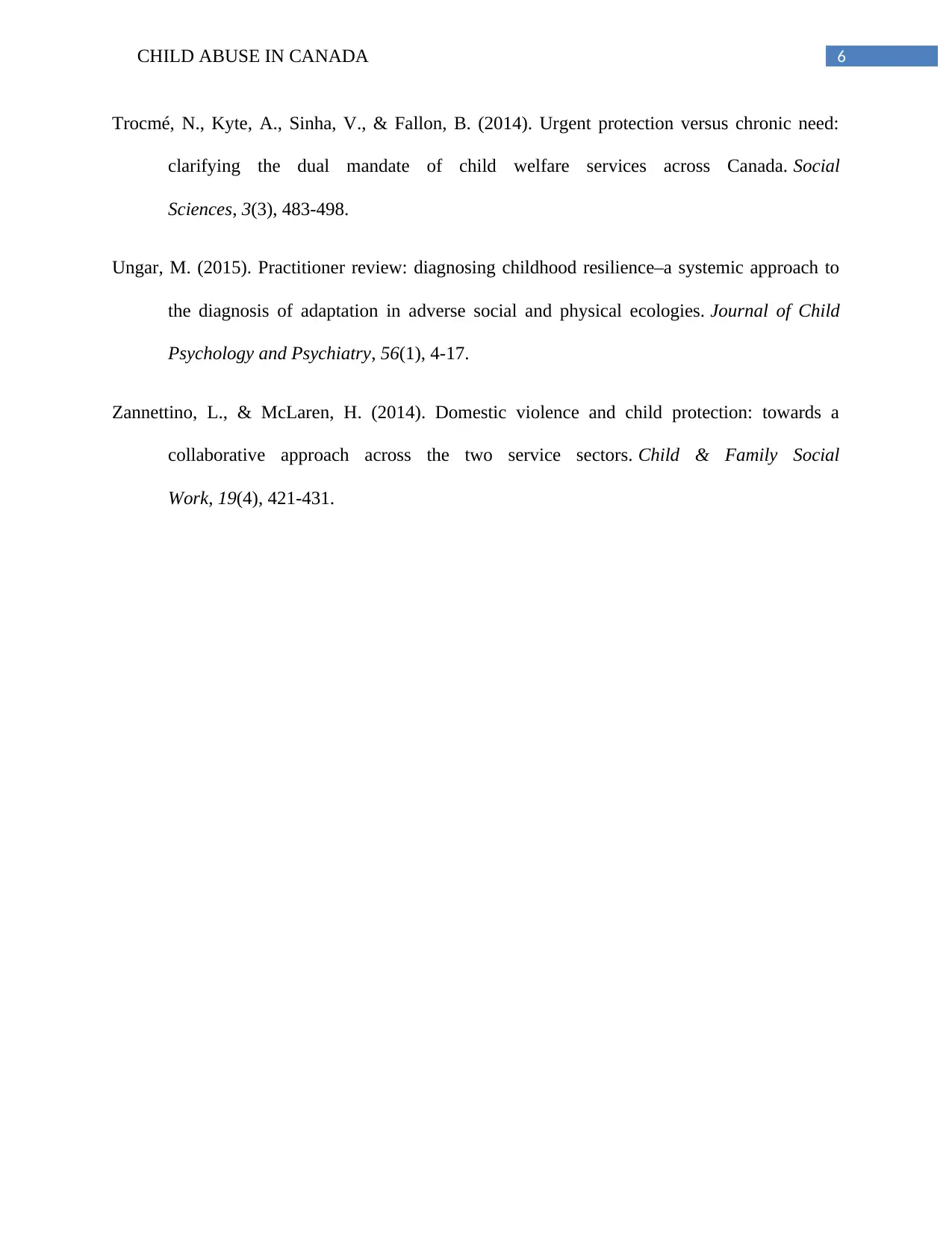
6CHILD ABUSE IN CANADA
Trocmé, N., Kyte, A., Sinha, V., & Fallon, B. (2014). Urgent protection versus chronic need:
clarifying the dual mandate of child welfare services across Canada. Social
Sciences, 3(3), 483-498.
Ungar, M. (2015). Practitioner review: diagnosing childhood resilience–a systemic approach to
the diagnosis of adaptation in adverse social and physical ecologies. Journal of Child
Psychology and Psychiatry, 56(1), 4-17.
Zannettino, L., & McLaren, H. (2014). Domestic violence and child protection: towards a
collaborative approach across the two service sectors. Child & Family Social
Work, 19(4), 421-431.
Trocmé, N., Kyte, A., Sinha, V., & Fallon, B. (2014). Urgent protection versus chronic need:
clarifying the dual mandate of child welfare services across Canada. Social
Sciences, 3(3), 483-498.
Ungar, M. (2015). Practitioner review: diagnosing childhood resilience–a systemic approach to
the diagnosis of adaptation in adverse social and physical ecologies. Journal of Child
Psychology and Psychiatry, 56(1), 4-17.
Zannettino, L., & McLaren, H. (2014). Domestic violence and child protection: towards a
collaborative approach across the two service sectors. Child & Family Social
Work, 19(4), 421-431.
1 out of 7
Related Documents
Your All-in-One AI-Powered Toolkit for Academic Success.
+13062052269
info@desklib.com
Available 24*7 on WhatsApp / Email
![[object Object]](/_next/static/media/star-bottom.7253800d.svg)
Unlock your academic potential
© 2024 | Zucol Services PVT LTD | All rights reserved.





